Advertisement
Review
Separated For Centuries, Titian’s 'Poesie' Reunite At The Gardner Museum In A Powerful Exhibition
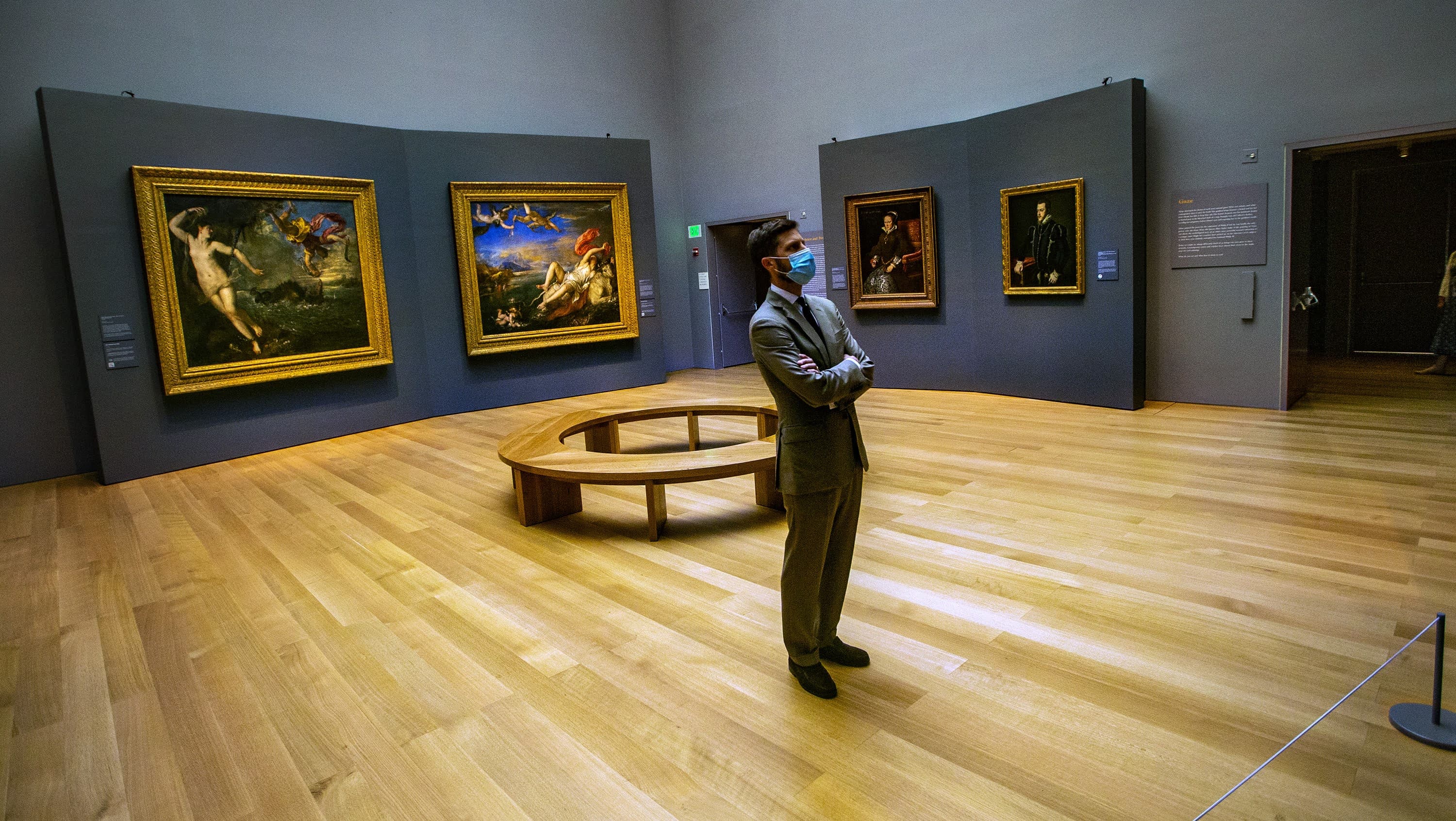
“Is the Pope going to sell you one of the rooms at the Vatican?” Henry James wrote to Isabella Stewart Gardner in 1896 when he learned that she had just acquired Titian’s “The Rape of Europa”—the first Titian in America and a painting many art connoisseurs still consider the greatest Renaissance painting in this country. James’s letter is on display in the anteroom to a new exhibition at the Isabella Stewart Gardner Museum, “Titian: Women, Myth & Power” (through Jan. 2, 2022), which made me think about other single rooms I would travel far to see. The Sistine Chapel, of course; the roomful of Bruegel masterpieces (including “Hunters in the Snow”) in Vienna’s Kunsthistorisches Museum; the gallery in the Uffizi with Botticelli’s sublime “Primavera”; the little room at the Mauritshuis, in the Hague, where Vermeer’s “Girl with the Pearl Earring” stares at his glorious “View of Delft” on the opposite wall.
We now have to add another amazing room, and it’s right here in Boston.
That room, at the Gardner Museum, includes a series of six canvases commissioned by the young King Philip II of Spain from Tiziano Vecellio (Titian) — a suite of large mythological paintings inspired by Ovid’s “Metamorphoses.” Titian called them “poesie” (painted poems) — arguing that painting could be as elevated as poetry. Titian is one of true poets among painters, and each of these paintings is a virtual poem — heroic, tragic, exciting, poignant, even comic. The whole set has not been seen together for nearly 500 years. Boston — after London’s National Gallery and the Prado in Madrid — is now the last of its three rarefied stops. It’s a very big deal.
And it’s wonderful.
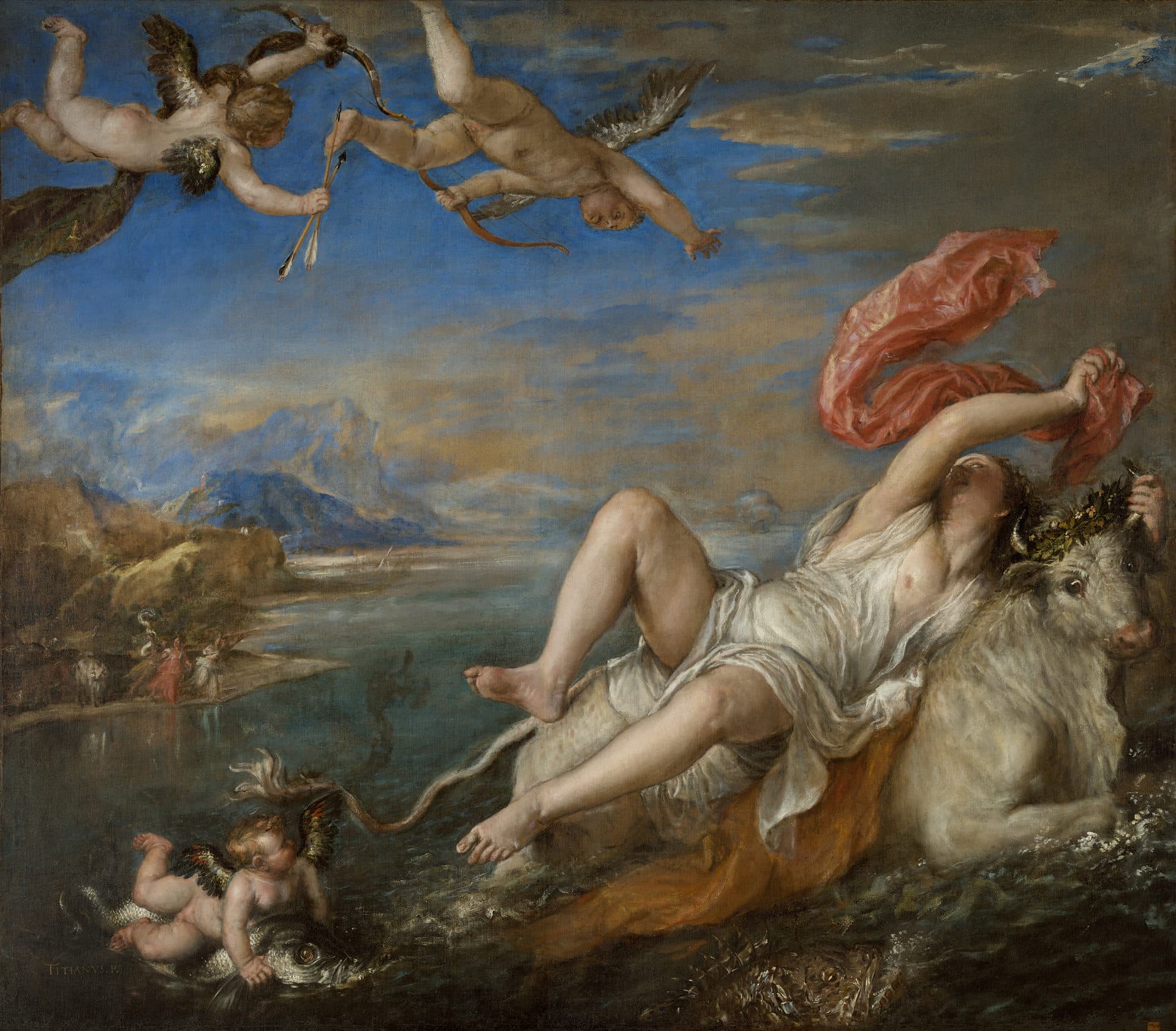
Above all, these paintings are sumptuously sensual. Titian was an astounding colorist. Just being surrounded by so many intense colors, some of them leaping from painting to painting, is a visual feast. The series took Titian a decade to complete. He began it at 60, already universally recognized as a great master, yet we find him continually exploring new ways to paint, his brushwork getting freer, more complicated, more daring, more “modern.” An exquisite little detail could be a still life by Manet. The synesthetic variety of Titian’s brushwork lets you feel the summer heat, smell the sea, feel the bubbles in the waves and the breeze on your face, join the movement of the figures in motion, hear the onlookers calling from the shore.

Not all of these paintings are in prime condition. The Gardner’s “Rape of Europa” is probably the best preserved, although long hidden under centuries of murky varnish, smoke, and charcoal dust from Mrs. Gardner’s fireplaces. It’s the only painting in the set that has been restored specifically for this show, and the results are breathtaking (what a treat to see it now at eye level!). The ultra-dynamic “Perseus and Andromeda” is the painting in the series Titian apparently reworked most. Andromeda, on the left, was originally on the right. As with “Europa,” we can see numerous places (“pentimenti”) where Titian changed his mind. At London’s Wallace Collection (which has never allowed any of its paintings to travel — until now), it’s always been a challenge to see. The compromised surface needs serious work, but here in Boston, superbly lit, it comes vividly to life.
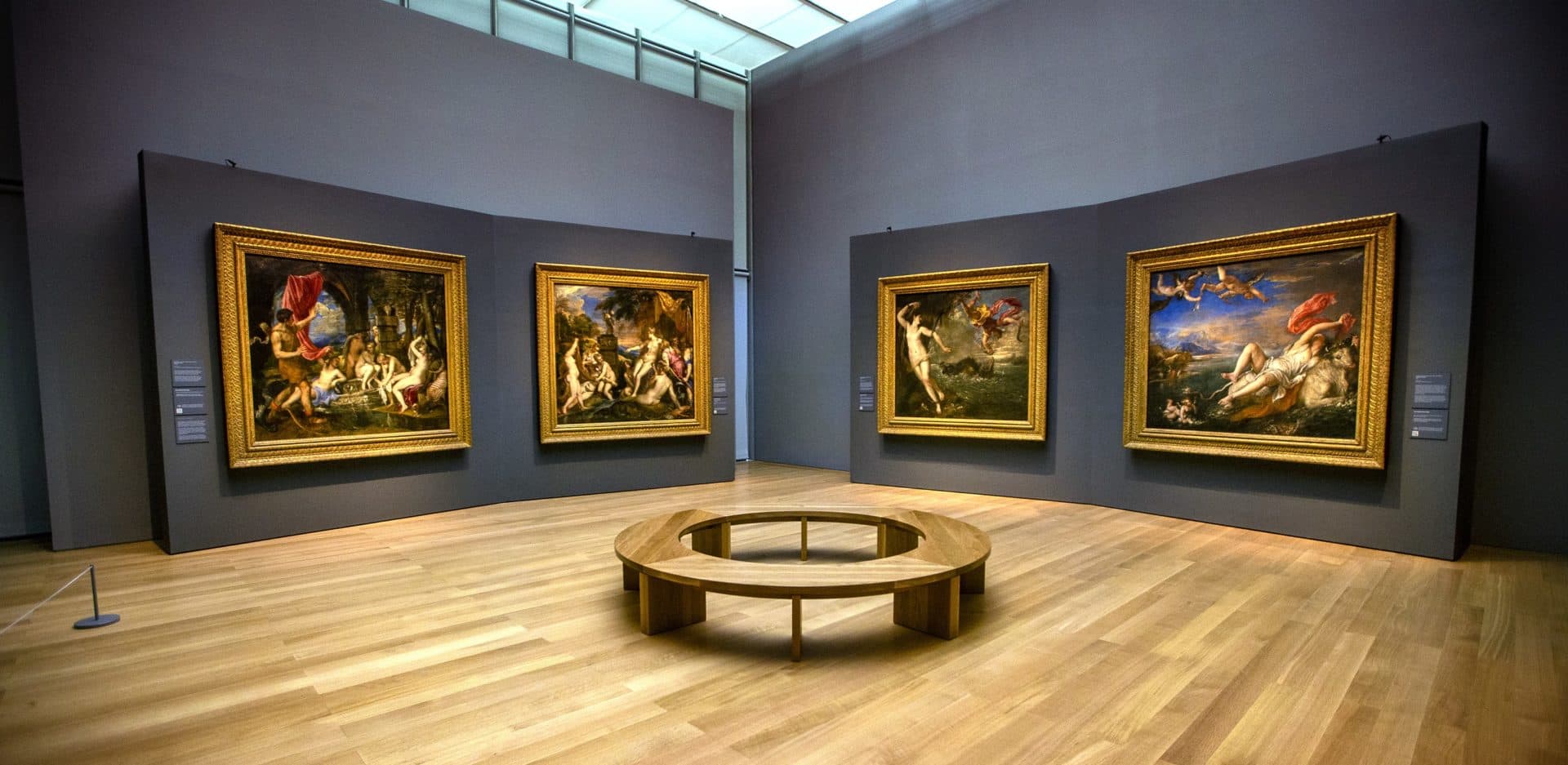
One outstanding feature of this show is curator Nathaniel Silver’s decision about hanging the paintings, quite different from the previous venues. Titian painted the series as three pairs. Silver installed in this gallery three walls, each holding a pair of paintings — “pendants” — each pair now more revealing because they are hung together. Seeing “Perseus and Andromeda” and “The Rape of Europa,” the final pair, individually, their structural similarities are hard to recall. Seeing them together, their similarities are thrilling.
Both paintings are about women in distress. Andromeda is chained to a rock, eyed by a hungry sea monster. Europa is being carried off by Jupiter disguised as a bull, plowing through the Mediterranean to Crete, where he will rape her. Their offspring will be the founders of “Europe.” (Silver tells us that part of Titian’s greatness is that he is not merely interested in events but in consequences). As Europa clings to the bull’s horn for dear life, ironic Cupids fly overhead or follow on fish-back (in a parody of Europa’s precarious position). Perseus is also flying through the air, about to descend on the sea monster so he can rescue and marry the helpless Andromeda. Europa’s friends and Andromeda’s family are visible miniatures on their respective shores. Flying figures, threatening maritime monsters, anxious groups, wafting red sashes — air, land, and water, and distressed heroines facing opposite directions (now virtually facing each other!). Silver’s inspired decision now gives us what may be our only chance ever to appreciate Titian’s rhyming connections.
Advertisement
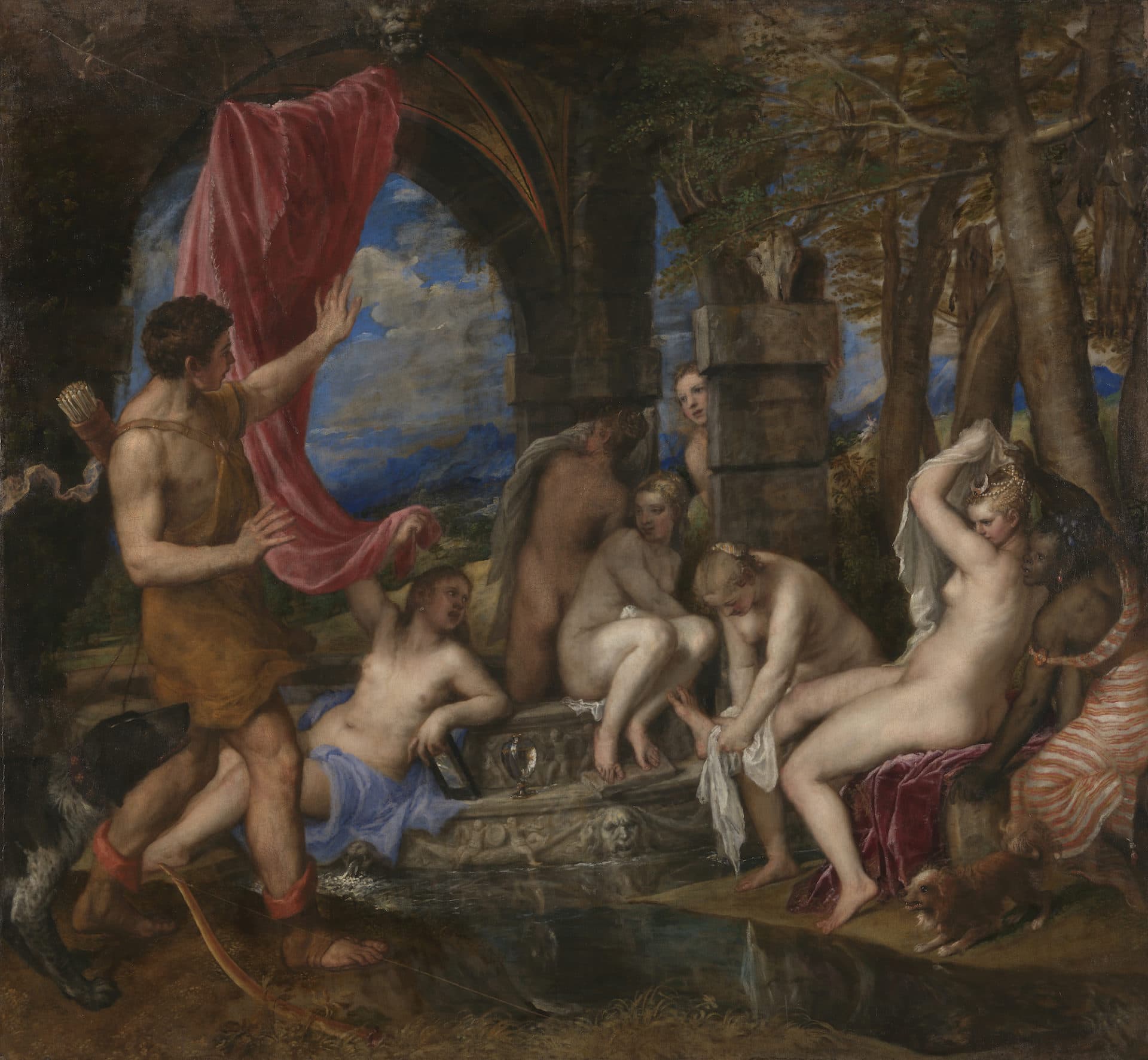
The two largest paintings depict painful stories of the cruelty of the goddess Diana (goddess of the hunt and of chastity): “Diana and Actaeon” (the most tragic painting in the series) and “Diana and Callisto” (both co-owned by the National Galleries of London and Scotland). The woodland stream with its idyllic reflections that Actaeon steps in continues into the next canvas to flow past Callisto, just as Diana’s cruelty continues from one painting to the next. Actaeon is the young hunter who accidentally stumbles upon the goddess and her retinue bathing. Her privacy invaded (in modesty or rage, she covers her face with her arm), Diana will turn him into a stag to be devoured by his own hunting dogs. His expression of surprise and shock suggests that he already foresees his fate (Titian injects the painting with subtle premonitions of his tragedy).
Callisto, one of Diana’s nymphs, has been raped by Jupiter. Titian’s goddess imperiously — mercilessly — orders her acolytes to rip off Callisto’s clothes and expose her pregnancy. The most touching details in the entire series are the barely noticeable teardrops slipping from Callisto’s eyes. Titian surely knew Virgil’s famous line about “the tears of things.”
The earliest of the “poesie” is an image of an actual rape, Jupiter descending upon Danae as a shower of gold. The ambiguous expression on her face (more beautiful than in any reproduction) doesn’t tell us if she’s terrified or greedy, though the old crone next to Danae’s bed is holding open her apron to catch some of the falling gold.
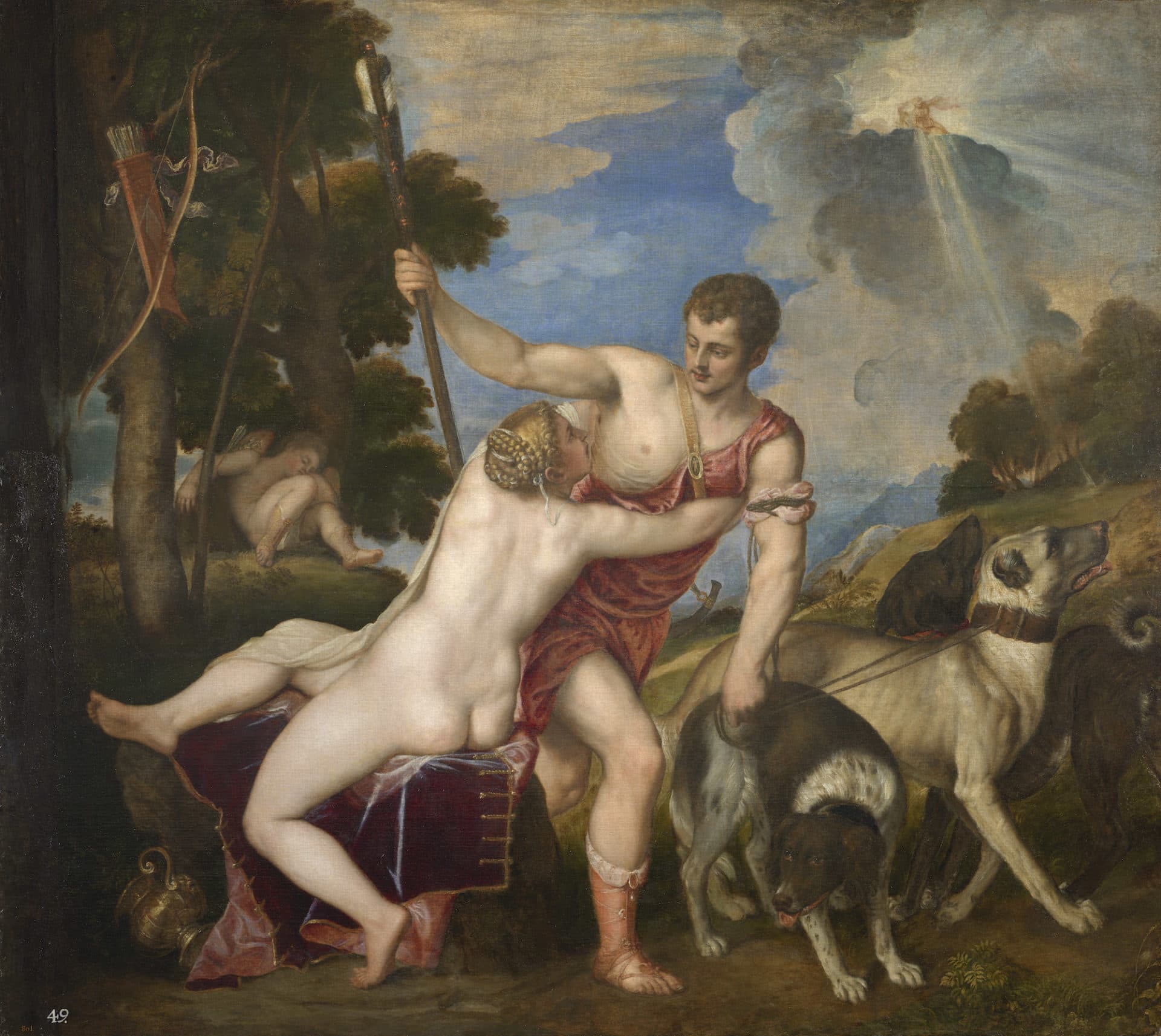
One of Titian’s most popular subjects in his lifetime was his “Venus and Adonis.” Many different copies survive (one is in the Metropolitan Museum; the one in this set is in the Prado). Unlike the standard myth, Titian paints the older and wiser Venus, still naked after their night of lovemaking, trying to stop Adonis from going hunting (she knows he’ll be killed), rather than Adonis trying to stop Venus from leaving. Watching from the fourth wall in this gallery are Titian’s (or his workshop’s) portrait of the young Philip and the Gardner’s own copy of Antonis Mor’s grim portrait of Philip’s wife-to-be Mary Tudor. The wall copy raises the question of whether Titian’s “Venus and Adonis” might be a commentary on the union between a younger man just coming into his power and his older, more powerful wife.
As opposing pendants, Titian paints Danae frontally nude and Venus nude from behind, twisting her body around to stop Adonis. One of my favorite visual rhymes shows one of Adonis’s hunting dogs twisting its head around into an almost parallel pose. I’m fond of all the dogs in these paintings. One of Diana’s hounds in the Callisto painting is stretched out on the river bank, its tongue hanging out, hot and fatigued. In the Actaeon painting, Diana’s pet lapdog is barking angrily at the intruder.
In all these mythological images, is Titian teasing the young Philip for his sexual prowess or warning him against the danger of royal sexual overdrive? Or both? Is Titian sympathetic to women suffering or is he — as some contemporary viewers will have it — just another male artist with a lascivious “gaze”? (These paintings reveal a lot of female flesh.) In one wall text, curator Silver asks: “How do we reconcile the beauty of a painting with the horror of its subject?” Think of another supreme tragic artist, William Shakespeare (whose first years overlapped with Titian’s last), or Aristotle, convinced that Beauty and Terror are inextricable. Art was never made just to provide reassurance. How can we survive as human beings without artists to show us human and divine nature in every aspect, to make something out of their vision — their gaze — that’s both deeply questioning and ravishingly beautiful? Artists like Titian.
“Titian: Women, Myth & Power” is on view at the Isabella Stewart Gardner Museum until Jan. 2, 2022.
